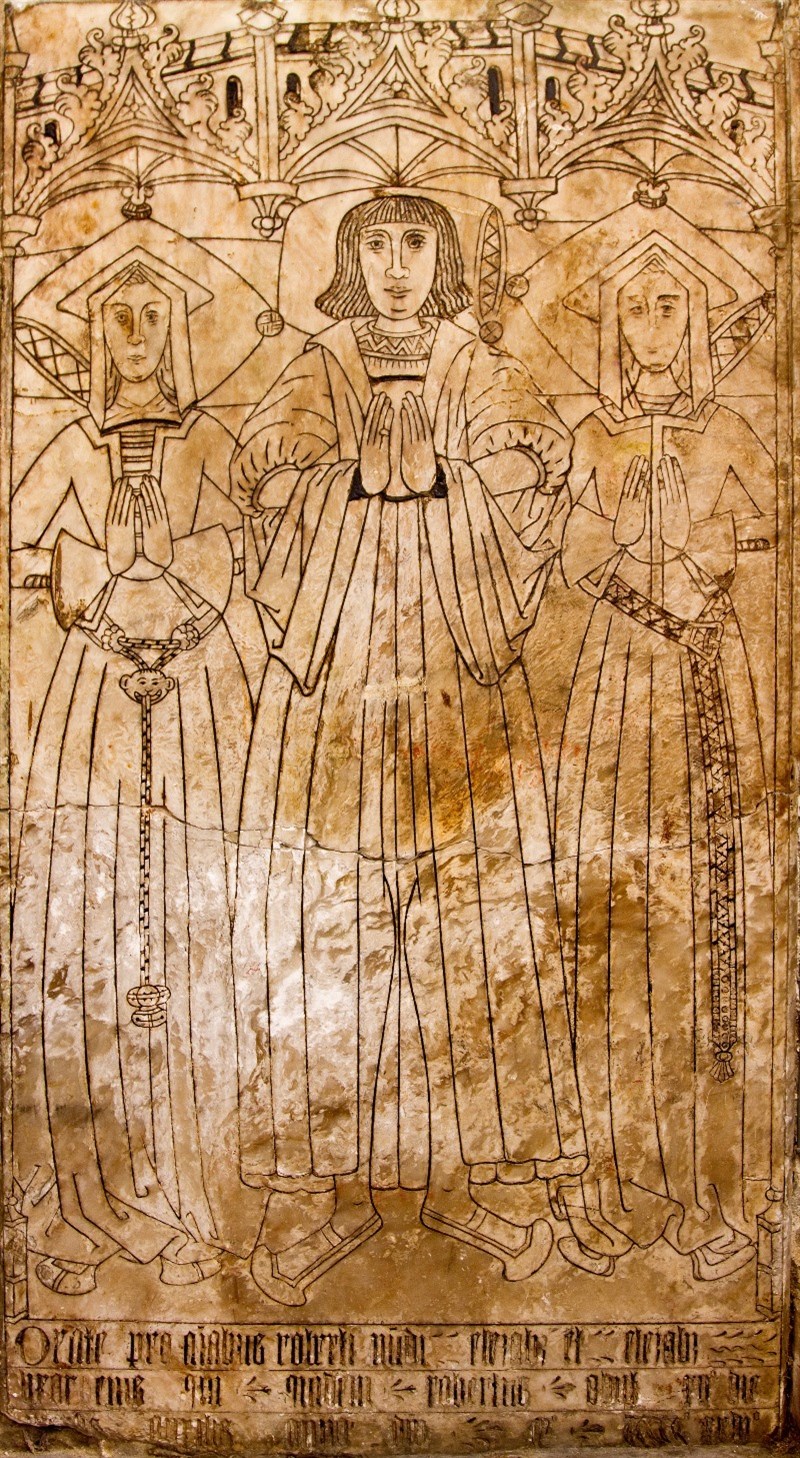Robert Nundi & his wives
Until recently, we knew very little about this monument, which stands against the west wall of the church.
Read on for the story of this fascinating monument, or follow the link and watch an animation by local film makers, Pudding Bag Productions, of Helen Bralesford's clever play, which was first premiered in the Church in July 2018.

It is an expensive alabaster monument, which would have been coloured and gilded when new. The alabaster is local, probably from Chellaston, and the black infill is pitch. The central male figure was clearly wealthy; he is depicted wearing fine clothes and a ring. The two women are fashionably dressed and wear fine girdles. The wife to Robert’s right wears a pomander at her waist, with a human face.
In medieval times, monuments were often designed to order during a person’s lifetime. Details were added as far as possible, leaving a gap for date of death.
From our reading of the inscription at the base of the monument, now indistinct through damage and proximity with the floor tiles, we believed the central figure to be Robert Mundi, flanked by his two wives, both Elizabeth. Then in January 2018 a visit from a member of the Church Monuments Society threw what we thought we knew up in the air.
Let's take a closer look at the inscription. It's in Medieval Latin and is much abbreviated.

orate pro a[n]i[m]bus Roberti Nu[n]di Elezab[ethe] et Elezab[ethe]
uxoru[m] eius qui quidem Robertus obitt XIIdie
mensis Aprilis anno d[omi]ni MCCCCCXXVI
(F A Greenhill – in “The Incised Slabs of Leicestershire & Rutland”. 1958, translates it as follows:
Pray for the souls of Robert Nundi Elizabeth and Elizabeth wives of Robert who died the 12th day of the month of April 1526.
Armed with ‘Nundi,’ we searched again … and found a will, which is in the care of the Leicestershire Records Office.
 Detail from will,
Detail from will,
It’s dated 9th March 1525/6 (the new year began in March at that time, so what was 1525 to them would be 1526 to us), very shortly before his death.
Robert requests burial at St Helen’s and makes several gifts to religious foundations – to ‘the mudder church of Lincoln’, the Brotherhood of Repton, the Abbey of Gresley and the ’nunnes’ of Langley Priory among others. He then makes bequests to several friends, before moving on to his wife, Alice, and sons Edward and Richard.
Alice is a surprise, as surely the monument describes two Elizabeths, but could a semi-illiterate stone carver have made a mistake, or could our modern eyes have read the inscription wrongly? It’s not much of a leap from ‘Elezab’ to ‘Alice.’
Alice, Edward and Richard all get half a dozen spoons, a ‘fedderbed’, bolster, pillow, blankets and a pair of sheets. Provision is made for Edward, 'till he be made preste if he be disposed for to be.'
Alice is given use of Robert’s lands and tenements in the Lordship of Ashby for the term of her life, thereafter to Richard and his heirs. Edward has life interest in the lands and, among other provisions, some money is to be used to pay the priest to pray for the souls of his father, mother and Alice. Edward, we deduce, is Robert’s son from his first marriage.
The residue of Robert’s goods after his funeral and payment of debts are to be disposed of by his executors amongst his wife and children and 'for the health of my soule as they shall thinke best'
Thanks to Carol Walton of Ashby Museum for her painstaking work, deciphering Robert’s will from medieval to modern English.
There is one more detail to add …
It’s clear from looking at the clothes Robert Nundi and his wives are wearing on the monument that Robert was a wealthy man. The bequests in his will confirm this. Part of his estate later went into the endowment of Ashby’s original grammar school in 1567. So where did his wealth come from?
A search through the National Archives at Kew found a case in the Court of Chancery, between Thomas Clarion, a fuller in London (a fuller cleaned wool) and Robert Nundi of Ashby de la Zouch, tailor. Its subject was the detention of deeds relating to half a burgage in Ashby. A burgage was a plot of land held by a freeman, or a man entitled to practise a trade within a town and to participate in electing members of the town’s council.
Robert Nundi was a householder, a landowner and a prosperous tailor in the town. Further research hasn’t brought up any more details yet. We don’t know what happened to his widow, Alice. We don’t know whether or not his elder son entered the priesthood, or whether his younger son followed in his father’s profession.
Research is ongoing. Watch this space!
Julie Starkey, 21/06/2020